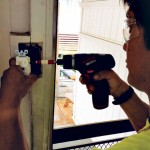Home Safety Heats Up
With the number of house fires on the rise where the cause of the fire was determined to be electrical, you have to wonder, could they have been prevented?
Fires are not only damaging to your property, they can potentially put your family, neighbors and their properties at risk as well.
If your home was built more than 40 years ago and has not had any electrical upgrades, there’s a good chance your wiring does not meet today’s safety standards as dictated by the National Electrical Code (NEC). The NEC states the requirements for safe electrical installations. It is part of the National Fire Codes series published by the National Fire Protection Association (NFPA). Homes of this age will often have three types of wiring: Aluminum (as opposed to copper), knob-and-tube wiring and two-conductor wiring.
Aluminum wire does not conduct electricity as well as copper does, and has a higher resistance. Over time, aluminum wire can deteriorate, become brittle and result in breakage.
Knob-and-tube wiring consists of ceramic knobs and tubes that the wire attaches to or passes through (joists or studs). Knob-and-tube wiring uses protective ceramic tubes placed in the holes to prevent the wire from chafing against the structure. It is not a grounded system, therefore it increases your risk for electrical shock hazards.
Two-conductor cable is a cable without a ground conductor, also known as bare-copper wire. A ground conductor acts as an additional safety conductor that provides a path to ground during a short circuit. This helps to reduce the chance of an electrical fire.
The potential for a fire hazard for these first two items are so great that most insurance companies these days will not insure a home containing aluminum or knob-and-tube wiring.
Here are indicators that your home’s electrical wiring may need upgrading:
• If there are frequent tripping breakers
• Crowded electrical panel
• Dimming/flickering lights
• Hot or discolored switch plates, cords or plugs
• Light bulbs that consistently burn out
• Buzzing/sizzling sounds
• Burning smell
• Arcs or sparks from an outlet when plugging in something
• Loose outlets
• Cracked insulation around your wires
• Electrical shock when touching a plug, cord, appliance or anything metal
The electrical strain on a home these days can increase because of many factors such as age and major home improvements or renovations, and the addition of major appliances or equipment such as an air conditioner, extra refrigerator, oven, dishwasher, washer and dryer, tank-less electric water heater, photovoltaic systems and an electric vehicle charger.
It is a good idea to have your home routinely inspected by someone who is knowledgeable and qualified, and can point out and properly repair any electrical hazards to keep you and your home safe. All G Electric is a local company with a vast electrical knowledge to help spot potential electrical hazards. Its highly skilled electricians can handle all types of installations and repairs.
The company has recently expanded its services to offer customers a comprehensive electrical inspection and testing to evaluate the home’s safety and efficiency. This inspection allows them to point out any areas of concern and potential fire hazard. Call today to schedule an electrical assessment at 531-2554 (ALLG).
ALL G ELECTRIC
contact // 531-2554 (ALLG)
email // info@allgelectric.com
web // www.allgelectric.com

